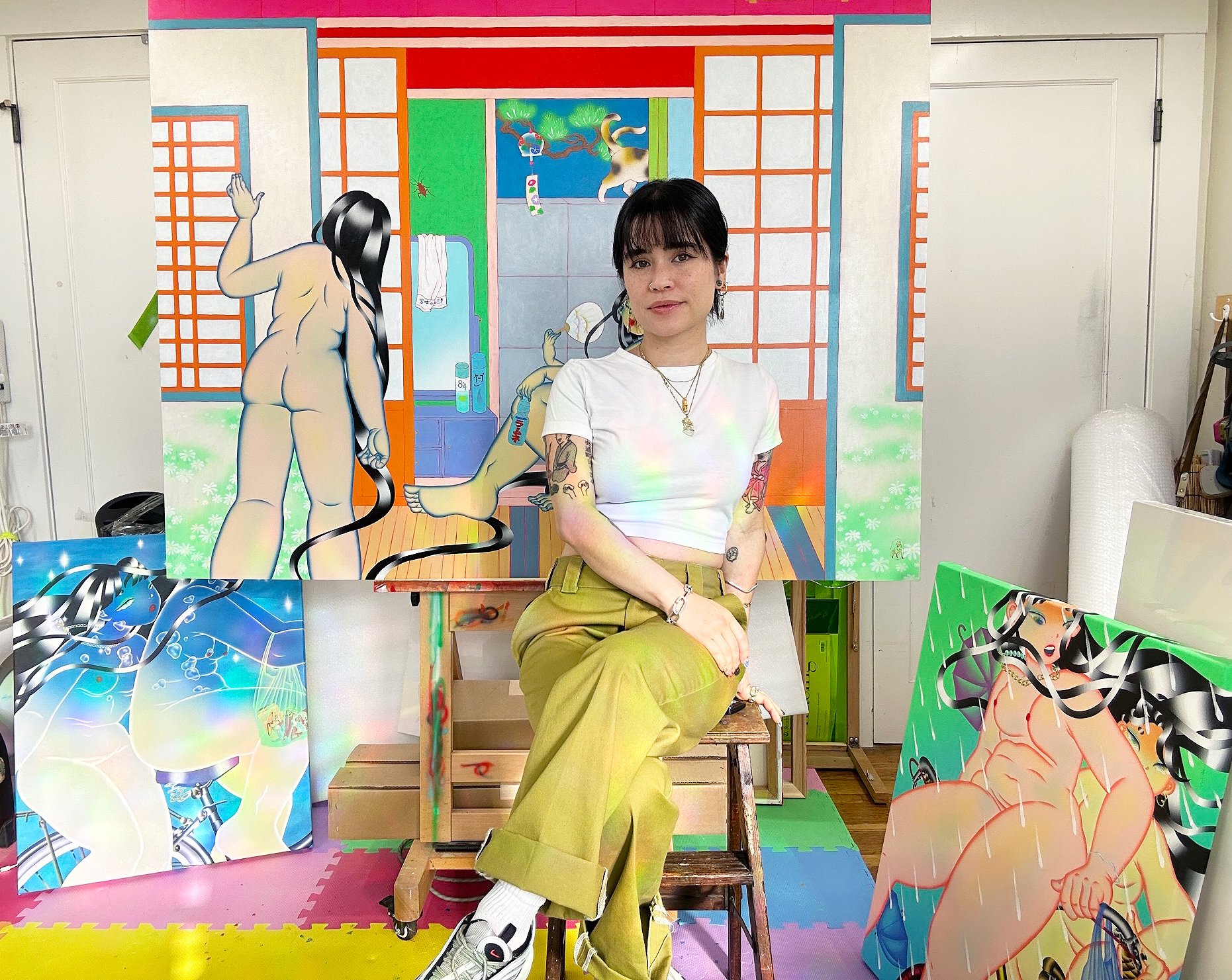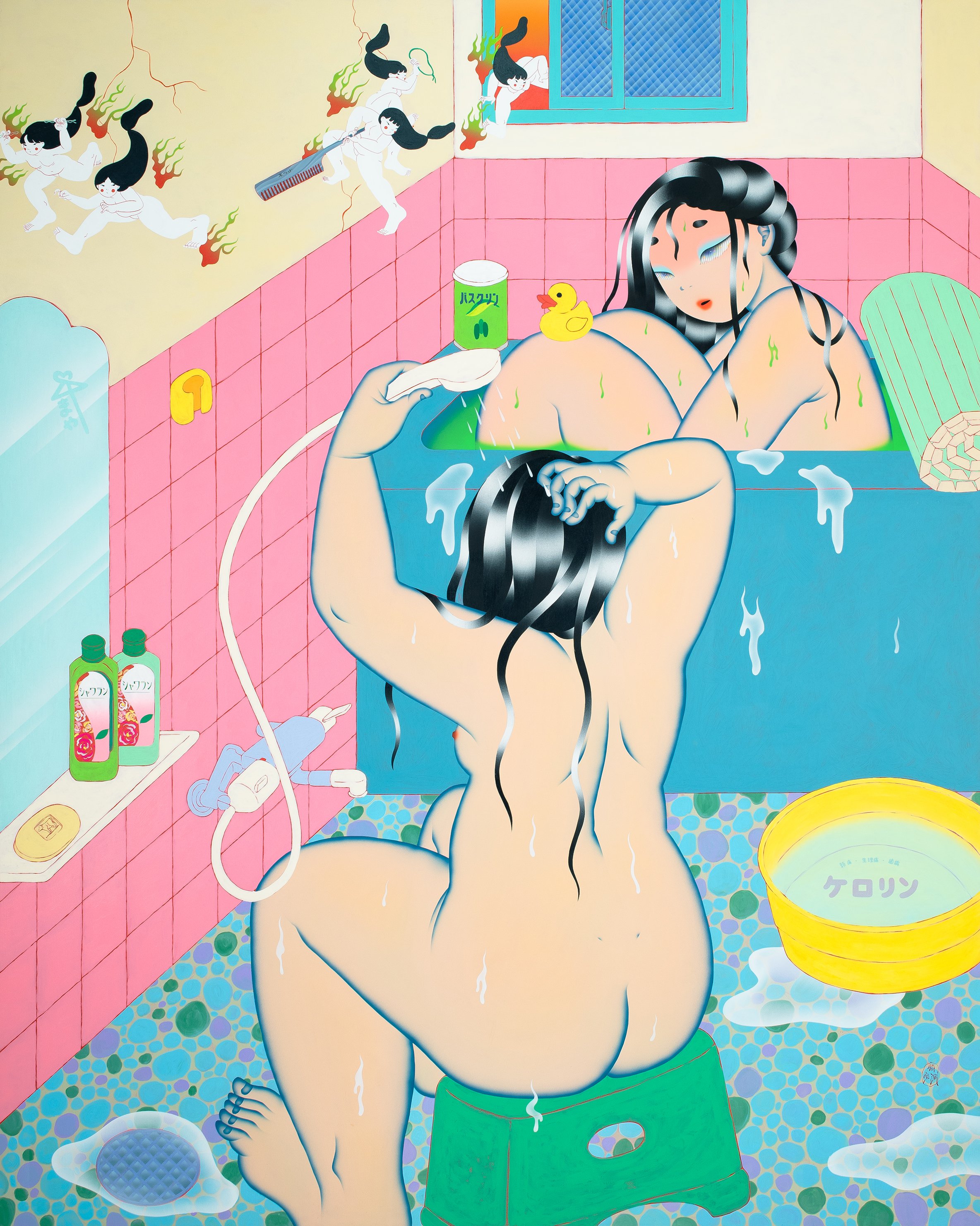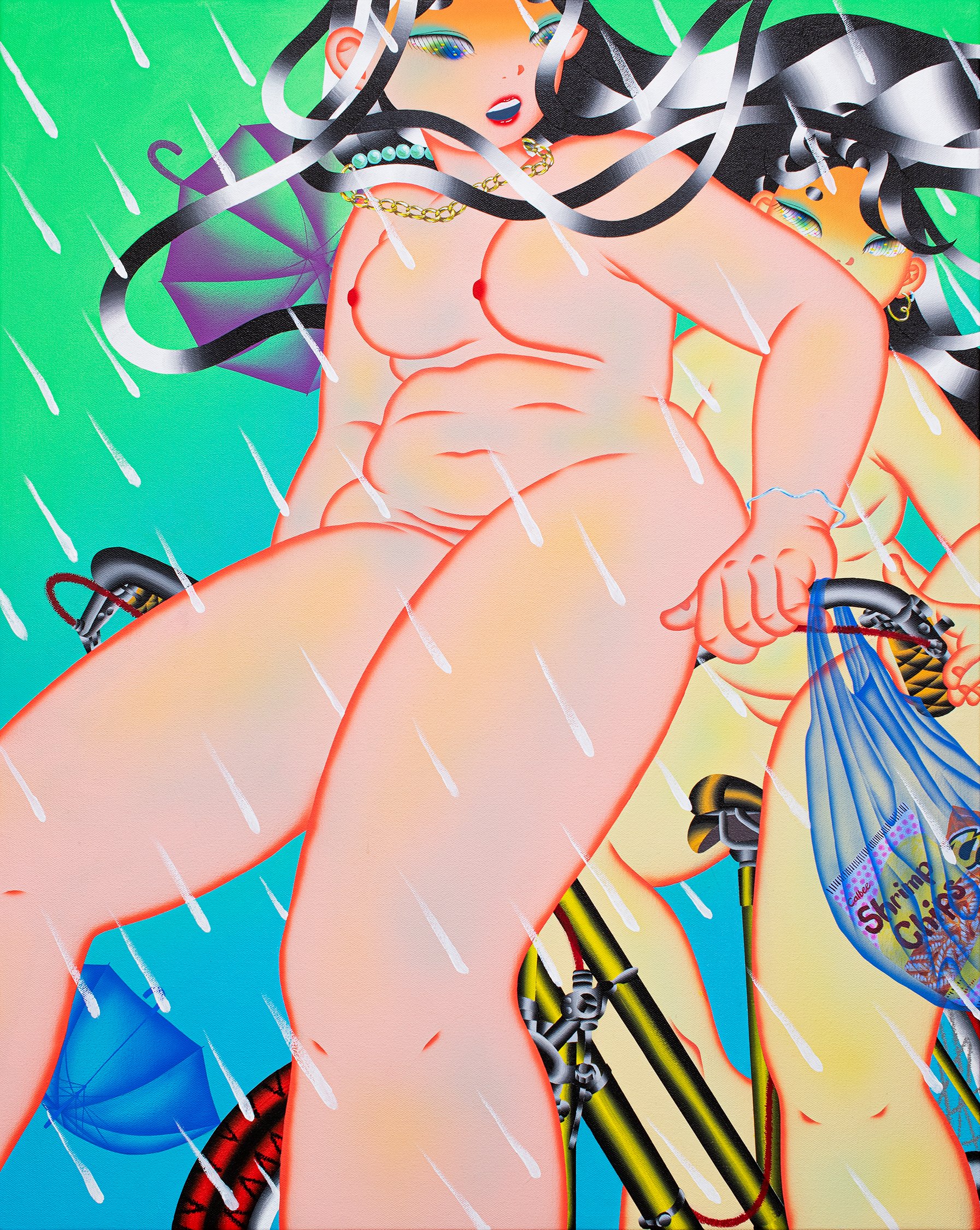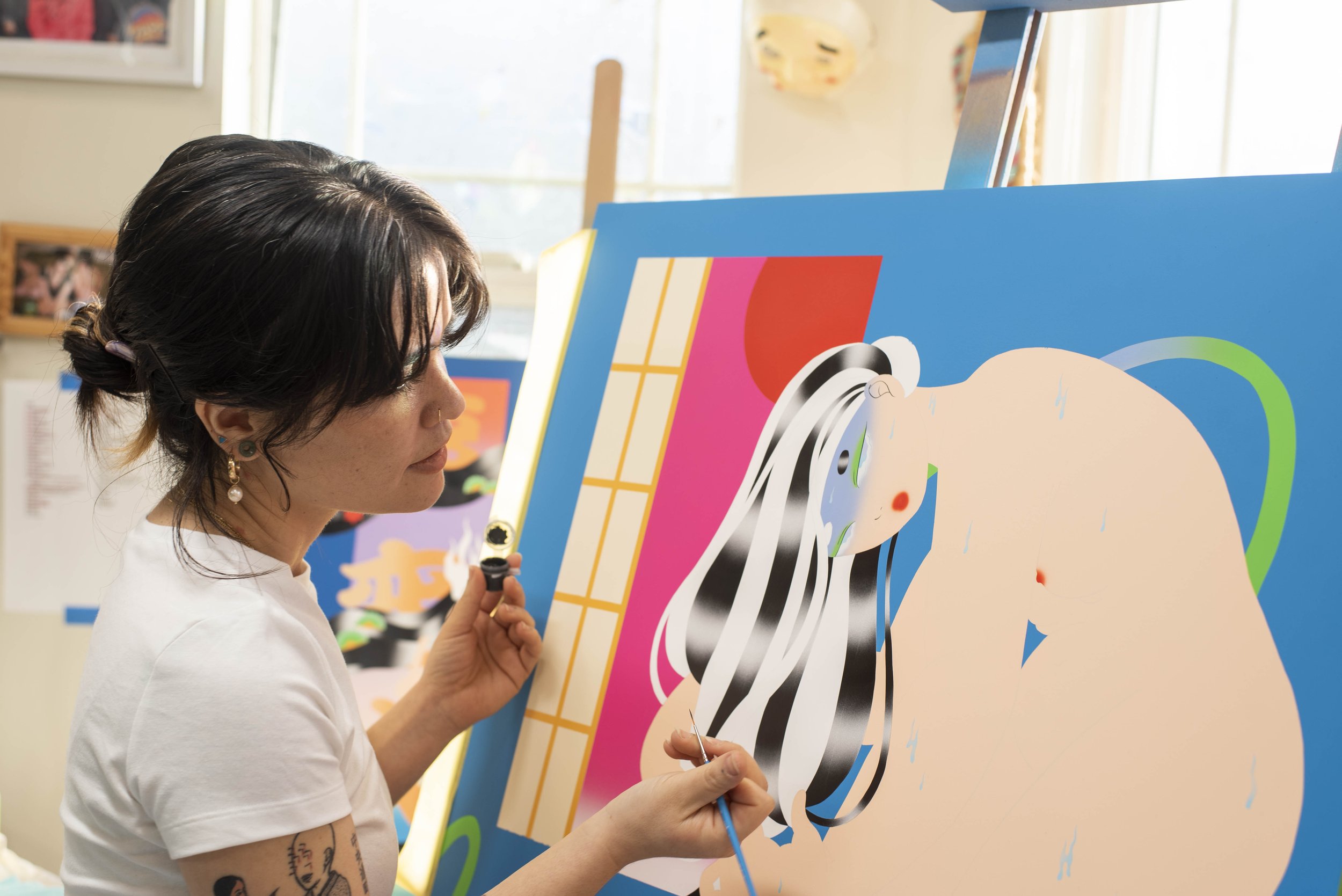
Maya Fuji
Born in Japan and raised in the California Bay Area, Maya Fuji is inspired by both her cultural heritage and the exploration of the liminal space she lives in.
Maya one of ArtConnect’s Artists to Watch '24
Born in Japan and raised in the California Bay Area, Maya Fuji is inspired by both her cultural heritage and the exploration of the liminal space she lives in as an issei (first-generation) mixed-race woman in the United States. She is fascinated by traditional Japanese mythology and folklore, as well as Showa and Heisei–era subcultures, and expands on these themes within the context of her personal experiences. A recurring theme in her work is the exploration of what forms our sense of identity, and how that can shift during one’s lifetime on account of generations living abroad. Imbuing the complexity of being multicultural, multinational, and multiracial is central to her works, as her paintings contrast the nostalgia of childhood memories with underlying feelings of being a foreigner simultaneously navigating Japanese and American communities. She illuminates self-discovery through narration and investigation of the otherness she has felt throughout her life, and uses it as a catalyst to reconnect with and reclaim space within her heritage.
Solo exhibitions include SWIM Gallery in San Francisco and YOD Gallery in Osaka. She has shown group exhibitions with New Image Gallery in Los Angeles in addition to Glass Rice and Hashimoto Contemporary in San Francisco. Fuji has been featured in publications such as New American Paintings, Friend Of The Artist, It's Nice That, Immigrantly Podcast, and was the winner of the Innovative Grant and was shortlisted for the Hopper Prize in 2023.
ArtConnect asked the winning artists to share with us a glimpse into their creative life to get a sense of their personal inspiration and artistic process.
How would you describe your artistic style and what inspires your work?
I think my artistic style has many influences. I draw inspiration from other artists I admire, both past and present, Japanese mythology, personal experiences, as well as my friends and family. These all have contributed to the development of my visual language, which continues to evolve as I uncover new aspects of myself. I spend concentrated time with my paintings and find that I continuously discover myself through them and what I hope to convey.
“I spend concentrated time with my paintings and find that I continuously discover myself through them and what I hope to convey.”
I always try to push myself through experimentation as I attempt to cultivate my visual language, nurturing its growth and fostering a dynamic lexicon that evolves and expands over time - I don’t want to stagnate into a specific “style.” I do find, however, that my constant is a focus on the feeling of joy. I want to feel like I can celebrate the cultures I come from and my subsequent perspective within my paintings. My sentiment has been to explore the multifaceted experiences of cultural hybridity and how that can create community in unexpected ways.
“Maya Fuji explores her own family history from a female perspective. In her paintings, we see nude female figures guiding us through domestic interiors and city streets. Maya uniquely combines the traditions of US-American pop art with Japanese visual culture. As an artist with a dual Japanese-American identity, she evokes her ancestors, ghosts of the past and mythical creatures, casting them into everyday and unusual settings. In her collage-inspired paintings, different time-spaces and geographies interweave, creating a kind of record of the artist's own life and history, as well as that of her communities.”
Could you share a memorable anecdote or story from your artistic journey that has had a lasting impact on you?
Earlier this year I was part of a group exhibition with Rosa Projects curated by Dr. Margarita Lila Rosa. At the end of the opening, all the participating artists sat in a circle in an impromptu artist talk. We all came from different cultural and ethnic backgrounds and began sharing our pasts, what motivates us to make art, and what narratives we want to convey through our practice. While a lot of the work was quite different at first glance, I found there was a common theme amongst us all: creating connection and community. It was a poignant moment, and something that continues to reverberate as a through-line, not only in my work, but many others that I meet.
What emotions or messages do you hope to convey through your work, and why are they important to you?
My work draws from my personal narrative and memories I’ve navigated through Japanese and Bay Area histories, cultures, and experiences. There’s a feeling of nostalgia and familiarity that emerges throughout my paintings depicting this inner world of mine, through unlikely juxtapositions. Additionally, as a homage to the intersections of my biracial identity, many of these depictions also create scenarios where neither culture is singularly represented, but instead as a blend. The figures live in a world where the “otherness” or “foreignness” fades away, anamorphically framed by my visual vocabulary utilizing my own specific memories and sentimental motifs. A third place.
Can you talk about a specific piece or series that holds a special significance to you?
Fujimura Tobacco Shop(藤村タバコ店)is a series of paintings I created in remembrance of my Obaachan (Grandmother), chronicling an interrogation of how one stays connected to culture when there is no physical place to return to. My Obaachan operated a small tobacco shop out of the front room in her home in Kanazawa, a small city in Northwestern Japan. I spent many months out of the year visiting her throughout my childhood, and would stay at her house during those times. The shop was a hub for people from the neighborhood, nostalgic of old-school community gathering spots. Many characters from the neighborhood would stop by to smoke cigarettes as they caught up on gossip in the storefront.
It was my home whenever returning to Japan from the SF Bay Area, where I immigrated to at an early age. My Obaachan and her shop were symbolic of my connection to Japan, and when she passed and her house caught on fire a few years later, I was very heartbroken. I realized the weight of this place I knew as home now only exists in my memories. As an Issei, or first-generation immigrant, it was my Obaachans stories and home that kept my relationship to my culture strong. The longer and further I was from my hometown, the more I felt my connection to this part of my identity slip away.
This series of paintings recreates imagery of my Obaachan’s home through the fragments of my memory, often blending moments spanning over years. Each painting is full of stories from the time spent visiting her, alongside references to the traditions of Kanazawa. Although some of these stories and symbols allude to loss and grief, there is also a joyful celebration of our culture and the profound beauty of day-to-day life in a typical Japanese household. Conceptualizing and painting this series was an uplifting act to mend and heal my own grief and loss.
What does it aim to touch on?
By enshrining my Obaachan’s legacy through the paintings in Fujimura Tobacco Shop, I hoped to reclaim and create a permanent connection to my Japanese identity and her being. This celebration of memory and diasporic experience is what connects me to the broader collective of Asian-Americans who are also preserving their own connections to culture and heritage. While remembering and generating pride, I place this as a central theme in my heritage as a radical act of reclamation.
Can you describe your creative process and the themes or concepts that drive your work?
My creative process often starts with an overarching theme that I explore through focused scenes or moments drawn from my memory. I think of my paintings as a method of storytelling, so I typically begin with exploring a narrative I’d like to share through my paintings. This helps me brainstorm what symbols or colors to include when conceptualizing. I then make a digital sketch on Procreate and play around with the color palette until I have a decent idea of what the painting will look like. In the past, I dialed in the digital version of the painting pretty precisely, but lately I’ve been keeping it a lot more loose to allow spontaneous experimentations as I paint.
Over the last year I’ve been exploring how Japanese and American culture (specifically Kanazawa and Bay Area culture) intersect within me, becoming more of a central theme in my work. Earlier works of mine focused on exploration on how to remain connected to my Japanese heritage while living in the US. However, I’ve recently shifted into exploring how ethnically mixed people, immigrants, and children of immigrants retain certain practices and traditions while letting go and picking up others. The longer I spend time in the United States, I’ve noticed the way certain habits of mine have shifted and morphed, often re-emerging as new ways of being.
I often surprise myself by the unexpected ways certain parts of each culture have taken root within me. We tend to think of tradition as something stationary, from the past, and passed on for generations, but I wonder what it means to carry tradition across the ocean to a new place, where it interacts and reacts with the local customs, beliefs, and other cultures of that region. How does tradition exist within pockets of immigrant communities and what ripples can it have if it were to become part of the greater local community?
“We tend to think of tradition as something stationary, from the past, and passed on for generations, but I wonder what it means to carry tradition across the ocean to a new place, where it interacts and reacts with the local customs, beliefs, and other cultures of that region.”
“Maya Fuji's artwork presents a captivating world, filled with dreamlike scenes and a wide variety of interesting characters and creatures. The emotions and messages conveyed by her pieces range from the beautiful and touching to the eerie and grotesque, with distorted landscapes and abstract designs adding to the overall effect. Her use of symbolism, both personal and historical, creates a immersive an delightful mixture of humor, sensuality, and tragedy, with images of both lost and lonely individuals and strange supernatural encounters. Maya Fuji's artwork envisions a multivalent, open-ended, and multicultural universe, folding in her own multi-sided background and experience.”
How do you stay motivated and inspired in your artistic practice?
I often draw inspiration from places or people I’ve spent time with, moments that stand out and leave a lasting visual impression in my mind. I am motivated by the challenges of overcoming obstacles. I enjoy challenging myself to see if I can effectively communicate my feelings through visual expression. When I feel I’m successful, It gives me the momentum to keep pushing my boundaries.
How do you balance your artistic career with the business aspect of being an artist?
I honestly would like the answer to this question as well. It’s an ongoing learning process that I hope to figure out one day!
How do you see the role of contemporary art in today's society, and how do you see your work contributing to this?
While contemporary art plays many roles in todays’ society, I am most drawn to its ability to stimulate dialogue, challenge perceptions, and offer fresh perspectives on complex social issues. Many contemporary artists come from a multitude of diverse cultural backgrounds, and there has recently been much more of a platform for artists of color to share our unique experiences. I aspire to contribute to this growing wave by inspiring, fostering connections, and offering insights into the unique experience of being a first-generation Japanese American of mixed race.
Anything else you would like to add?
I am currently working on new paintings for an upcoming solo exhibition at New Image Art Gallery in Los Angeles in April 2024. It will be a continuation of Fujimura Tobacco Shop, highlighting memories and folkloric tales.
See more of Maya’s work







